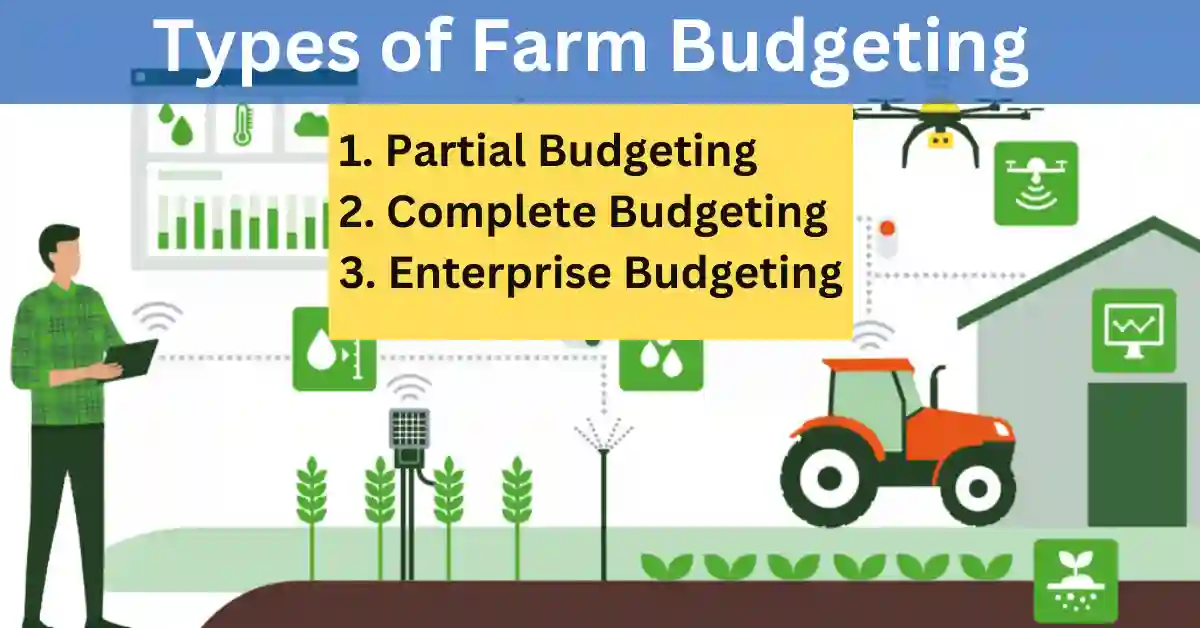Agricultural success often hinges on effective financial planning, and one crucial aspect is understanding the three types of farm budgeting.
In this article, we’ll delve into these essential approaches that empower farmers to manage their resources wisely.
From partial budgeting to strategic investments, mastering types of farm budgeting is key to sustainable farming practices.
Definition of Farm Budgeting:
The expression of a farm plan in monetary terms i.e. by the estimation of receipts, expenses, and net income, is called farm budgeting.
In other words, farm budgeting is a process of estimating the costs, returns, and net profit of a farm or a particular enterprise.
Types of Farm Budgeting:
Farm budgets are classified into enterprise budget, partial budget, complete budget, or whole farm budget. Farm budgeting is a method of examining the profitability of alternative farm plans.
1. Partial Budgeting:
Partial budgeting is the cornerstone of day-to-day financial management on a farm. It involves estimating the costs associated with regular activities such as planting, harvesting, and livestock care. By carefully planning and allocating resources, farmers can ensure the smooth running of their operations.
Embracing three types of farm budgeting in partial planning includes sustainable farming practices, reducing energy consumption, and implementing efficient water management systems.
Partial budgeting technique is generally used to evaluate the profitability of input substitution, enterprise substitution and scale of operation.
1. Added costs: Additional costs are incurred, if the proposed modification is the introduction of a new enterprise or an increase in the size of the existing enterprise.
2. Added returns: Additional returns could be received when the proposed modification is the addition of a new enterprise, increase in the size of the existing enterprise, or adoption of technology that results in higher productivity.
3. Reduced returns: A decrease in the returns is observed when the proposed modification involves the elimination of an existing enterprise or reduction in the size of the existing enterprise.
4. Reduced costs: A decrease in costs is found when the proposed modification involves the elimination of an existing enterprise reduction in the size of the enterprise or the adoption of a technology that uses fewer amounts of resources.
2. Complete Budgeting:
Complete budgeting revolves around major investments that impact the long-term success of a farm. Whether it’s acquiring new equipment, expanding facilities, or adopting advanced technologies, complete budgeting helps farmers make informed decisions.
Integrating three types of farm budgeting into capital planning may involve investing in eco-friendly equipment, renewable energy sources, and organic farming techniques. These choices not only benefit the environment but also contribute to the farm’s overall sustainability.
3. Enterprise Budgeting:
Enterprise budgeting focuses on specific components or enterprises within a farm, such as crops or livestock. It provides a detailed breakdown of revenue and expenses associated with each enterprise, aiding farmers in identifying the most profitable aspects of their operation.
Incorporating three types of farm budgeting into enterprise budgeting might involve diversifying crops, implementing rotational grazing for livestock, and exploring organic certification to tap into niche markets with higher demand for sustainably produced goods.
Importance of Farm Budgeting:
Farm budgeting is essential for financial planning, risk management, resource optimization, goal setting, and facilitating communication and decision-making. It plays a pivotal role in ensuring the economic viability and sustainability of agricultural operations.
1. Financial Planning:
Farm budgeting is crucial for effective financial planning on the farm. By outlining anticipated revenues and expenses, farmers can gain a comprehensive understanding of their financial position. This allows them to make informed decisions about resource allocation, investment, and risk management, ultimately contributing to the overall economic sustainability of the farm.
2. Risk Management:
Farming is inherently subject to various uncertainties such as weather conditions, market fluctuations, and unexpected expenses. A well-prepared budget serves as a risk management tool by helping farmers identify potential financial challenges and devise strategies to mitigate them. This proactive approach enhances the farm’s resilience to unforeseen events.
3. Resource Allocation:
Budgeting assists farmers in optimizing resource allocation, including labor, land, and capital. By forecasting expenses and income, farmers can allocate resources efficiently, ensuring that inputs are used judiciously to maximize yields and profits. This careful planning is especially critical in the face of fluctuating commodity prices and production costs.
4. Goal Setting and Evaluation:
Farm budgets provide a framework for setting financial goals and objectives. Whether it’s expanding operations, purchasing new equipment, or reducing debt, a well-structured budget helps farmers articulate and work towards their financial targets. Regularly comparing actual performance against the budget allows for ongoing evaluation and adjustments to ensure goals are met.
5. Communication and Decision-Making:
Farm budgets facilitate communication and collaboration among farm stakeholders, including family members, business partners, and financial institutions. A clear budget provides a shared understanding of the financial goals and constraints, fostering effective communication. Additionally, having a budget in place aids in informed decision-making, allowing farmers to evaluate the financial implications of various choices and make strategic decisions that align with their overall objectives.
Conclusion:
In conclusion, mastering farm budgeting, specifically the types of farm budgeting, is essential for any farmer aiming for long-term success and sustainability. By incorporating natural ways into partial, capital, and enterprise budgeting, farmers not only enhance their financial viability but also contribute to a healthier and more sustainable agricultural industry.
As you navigate the complex landscape of farm finances, remember that balancing economic success with environmental responsibility through three types of farm budgeting is the key to a thriving and resilient farm.

